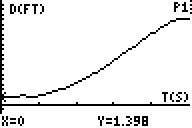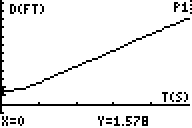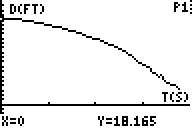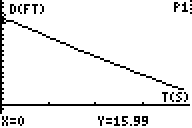



figure 1 figure 2 figure 3 figure 4
Chapter two notes
Aristotle's Classification: Believed in natural and unnatural motion
a.) natural motion: Is directed up or down. Like a leaf falling or a puff or smoke rising. He also said that it is natural for heavier objects to fall faster than light ones.
b.) unnatural motion: required a force such as a push or a pull. He also thought that anything in motion had an unbalanced force acting on it.
Galileo's classification:
a.) Through careful observation and experimentation (dropping objects and also working with inclined planes) found that except for the effects of air resistance, all objects regardless of mass fall at the same rate. (Remember the experiments of dropping the flat paper, paper wads, and books.)
b.) also discovered the property of inertia. In other words an object could be moving at a constant velocity with no unbalanced force acting on it!
Galileo's experiment: Galileo experimented by rolling objects down inclined planes (ramps) If I put two ramps together so they are at exactly the same angle and start a matchbox car down one side, how far will it go up the other side of the incline? Here is the video If you said the same height you would be correct. However, if you notice it is slightly less do the friction of the car wheels on the track. I can reduce friction if I use a marble instead of the car. So in this video you will notice that the ball almost comes up to the same height as it started. What happens if I decrease the incline on one side of the set-up. Will the ball still roll up to the same height? Here is the video Notice that the ball almost makes it up to the same height. It travels a greater distance but the vertical height is the same as from where the ball started. So without friction the ball will roll up the same vertical height as it was started. What if we let one end of the ramp completely down. See video. If there were no friction, what would happen to the ball. If you think that it will keep going on and on forever you are correct!. Notice that there are no forces pushing the ball in the horizontal direction it jumps keeps going by itself. Galileo called this property inertia!
FALLING OBJECTS
Aristotle: Heavier objects fall proportionally faster than light objects.
Galileo: Ignoring air resistance, all objects will fall at the same rate.
VELOCITY
Velocity is speed AND direction. 30 m/s East is a velocity.
Velocity is a vector quantity. Vectors have both an amount (magnitude) AND direction.
Speed is a scalar quantity. Scalar quantities have amount (magnitude) OR direction but not both
The average speed of an object is the total distance divided by the total time. Common units are miles/hour and m/s. Remember from class that 1 m/s is equal to 2.237 mph. If you are going 100 m/s that is the same as 223.7 mph.
Constant velocity means you have a constant speed and you do not change direction. Remember anytime you change your speed OR direction you have changed your velocity.
According to Newton's first law and object at rest will stay at rest and an object in motion will stay in motion (ex. constant velocity) unless acted on by an outside force. Therefore to change the speed OR direction of an object you must apply a force to the object.
GRAPHS




figure 1
figure 2
figure 3
figure 4
What type of motion does each graph show?
Can you draw a velocity time graph for figure 1 and 2
Relative Motion
Motion is always measured relative to something else. When you drive your car down the road at 50 mph you are going 50 mph relative to the surface of the earth. If car A is going down the road at 50 mph and car B is going down the road at 50 mph (both in the same direction) then their relative speed to each other is 0 mph. If car A is going 50 mph EAST and car B is going 30 mph EAST then the relative speed of car A to car B is 20 mph. The relative speed of car B to car A is -20 mph. Draw diagrams for these types of problems to help you solve them. Remember the discussion about moving sidewalks in class.
Here is a windup toy car placed directly on a desk. Notice its forward motion. Here is that same car but this time I have it on some paper that I am pulling to the right. What is the relative velocity of the car now?
Inertia: Is the resistance to change of motion. It depends on mass. The more mass the more inertia. It is NOT a force because there is no net push or pull on the body.
Newton's 1st law of motion ( law of inertia): An object at rest will stay at rest and an object in motion will stay in motion (in a straight line) unless an outside force acts on it.
If a ball on a cord is swung in a circle it will travel in a circle because you are "forcing" it to go in a circle. If you cut the cord, the ball will fly off (tangent) in a straight line because you have removed the outside force.
Remember when you are driving in a car you are an object in motion and you want to stay in motion. If the car is going 65 mph then you are also going 65 mph. If you hit a tree which stops the car you will continue you in a forward motion at 65 mph until you hit something to stop you such as the steering wheel, windshield, etc. In some cases you may actually fly threw the windshield. Therefore you need to wear your seatbelt which prevents you from continuing in the forward direction. Remember you are not being pushed forward you are in motion and want to stay in motion. Here is the video of the car with the egg with no "seatbelt" and the car with the egg with the "seatbelt" Notice that the egg in the first case stays in motion and hits the front of the cart.
Here are some video's of Newton's first law in action. Be prepared to
tell how each video demonstrates Newton's first law
a.) Coin on cup
b.) Spinning raw egg and touching it
c.) Spinning hard boiled egg and touching it,
e.) Inertia brake for a car(remember watch the piece of
chalk in the back move forward as the car comes to a stop. This is simulating the
same mechanism that "locks" your seatbelt in your car.
f.) Egg on the dinner plate
g.) Removing toilet paper the correct way
h.) Removing toilet paper the incorrect way
i.) Incorrect Tablecloth trick
j.) Correct tablecloth trick #1
k.) Correct tablecloth trick #2
l.) Watermelon slicing one
(The top of the watermelon should land back on the bottom when done correctly)
m.) Watermelon slicing two
n.) clumps of clay on a
hanger
Net force: The combination of all forces that act on an object.
A force is a push or a pull. A force is a vector quantity because it has an amount and a direction.
When a ball hangs from a string what are the forces ON THE BALL? (gravity down on the ball and the string up on the ball) The net force on the ball is zero)
Equilibrium
An object is at equilibrium when their is no net forces. This can occur under two conditions
Static A = No motion the object is at rest ( like a book on a table)
Dynamic Condition B = An object is traveling at constant velocity (no slowing down not speeding up and not changing direction)
The first concept is fairly easy to understand but what about an object at constant velocity? Think about pushing your lawnmower across your yard. What impedes your motion? Hopefully you thought of friction. What type of motion would you have if the applied force was greater than the friction force? (acceleration. ie. speed up) what type of motion would you have if the frictional force was greater? (deceleration. ie slow down) What type of motion would you have if the applied force was equal to the frictional force? (constant velocity)
remember a constant force produces a constant acceleration not a constant velocity. (Remember pulling Nikki on the skateboard?)
so for equilibrium å
Parachute problems:
When a parachute falls in free fall (before they open their chutes) what are the forces acting on them? Gravity (or weight) down and air resistance up. Are they balanced (Sum of F = 0)? In this case the weight of the skydiver is greater than the air resistance up so the skydiver speeds up (accelerates) on their way down.
Once the chute opens, then the force down (weight) is now equal to the
force up (air resistance) and the skydiver moves at a constant
velocity downward. Remember this is dynamic equilibrium (å
A book resting on a table is an example of static equilibrium
(å
When å
Support force: Is an upward force against gravity. Good thing we have this on our floors or we would be falling through them all of the time. A spring can also be a support force in resistance to when you push down on a spring. Remember even if you cannot see the support force like when a book is resting on a table it is there. The weight of the book squeezes downward on the atoms and the atoms will squeeze up on the book. Remember when we placed the 1 kg mass on the ruler between the table. You can plainly see the bend in picture one and little less in picture two and even less in picture 3. However, there is still an upward force being exerted whether you can see the bend or not. Finally remember how we related this to the force hoops in class
The moving earth: If you are in your car traveling down the road and you throw a penny upwards, where will it land? (in front of you, behind you, or back in your hand? Why? Remember you have inertia, and the penny has inertia. Since objects in motion want to stay in motion the penny will continue to travel forward whether it is in contact with your hand or not. Therefore it will land right back into your hands. Tossing the tennis balls in the pickup (Will the you catch the ball or will the ball land in the street? Why?)
You may be interested in looking at the links below. You will not be tested on them they are for your enjoyment!
Here is an applet on relative motion
Vector Applet on boat crossing a river